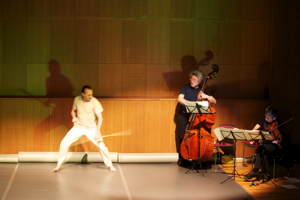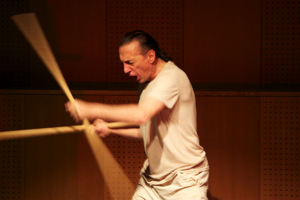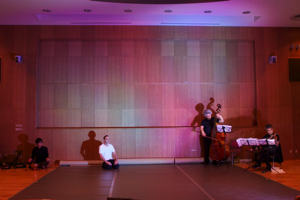Looking for Kenji (step one) creation 2011,
11th. of March, one year after Fukushima.
Choreography:..................... Jean Laurent Sasportes
Music Composition: .............. Tetsu Saitoh
Music Interpretation: .............Tetsu Saitoh (Doublebass und Percussion)
,
....... Naoki Kita (violin and telling)
Dancers:..............................Jean Laurent Sasportes
This piece was inspired from the poems and ltterature work of Kenji Miyazawa, a very important japanese writer.
About Miyazawa Kenji -
Kenji Miyazawa (宮沢 賢治 Miyazawa Kenji, 27 August 1896 - 21 September 1933) was a Japanese poet and author of children's literature in the early Shōwa period of Japan. He was also known as a devout Buddhist, vegetarian and social activist.
Kenji has transcended the generations to become one of Japan's most read and best loved authors. Born over a hundred years ago in 1896 in Iwate Prefecture, he was only 37 at the time of his death. Kenji's literary works received scant attention during his lifetime and only two books were published before his passing: a collection of children's tales entitled "The Restaurant of Many Orders" and the first section of his most famous work of poetry, "Spring and Ashura." The remainder of the great number of children's stories and poems that he left behind was edited and published only posthumously, after which the richness and depth of his art finally gained wide recognition.
He died in 1933 of pneumonia.
for more information aout Kenji Miyazawa, please visit:  http://fr.wikipedia.org/wiki/Kenji_Miyazawa http://fr.wikipedia.org/wiki/Kenji_Miyazawa
Why Kenji Miyazawa?
The fisrt reason was that after reading some fairy tales writen by Kenji, I expressed my enthusiasm to my friend Roger Pulvers who is director of the CSWC at the Tokyo Technology Institute. Roger was Kenji's english translator for his poems and he published a translation of a selction of Kenji's poems with the title "Strong in the Rain". SInce I was working as adjoint professor for the CSWC, Roger asked me to choreograph and dance a piece based on some of Kenji'spoems. This demand was done a few months before the drama of 11th. of March 2011, but was supposed to be presented in May 2011. I was supposed to travel to Tokyo on the 14th. of march to start my work on ths piece, but because of the earthquake, the tsunami and the nuclearplant accident, I decide to delay my trip to the 14th. of april. So, when i started to work on this piece with Tetsu Saitoh, we realized that doing a piece about Kenji Miyazawa in Japan after 11th. of March had another connotation then before. For many reasons that I will develop later, a work about Kenji would be, for the japanese public, necessary closely connected to what happened in Fukushima prefecture and because of this matter touch a very sensitive theme.
Kenji Miyazawa and the 11th. of March.
On June 15th. 1896, year of Kenji's birth, Iwate Prefecture was hitten by a very strong earthquake and tsunami (Meiji-Sanriku earthquake). This quake occurred off the coast of Sanriku in Iwate Prefecture, causing a tsunami of 25 m (82 ft) 35 minutes after the quake which destroyed hundreds of houses and killed over 22,000 people. The year of his death (21st. September 1933), also happened "1933 Sanriku earthquake", a major earthquake whose associated tsunami caused widespread damage to towns on the Sanriku coast of the Tōhoku region of Honshū, Japan in 1933.
Japan, in its earthquake and Tsunami history had unfortunately to suffer very often from particularely strong seismic disaster, and there is nothing to see in relation with Kenji's birth year and death year then a simple matter of fact.
Some of those major earthquake and tsunami left many dead and injured victims behind them and it has been certainly a tremendous hard work for the population to rebuilt their country and its agriculture potential. But the 2011's major one had one more high dramatical side in it. The disaster left thousands dead and inflicted extensive material damage to buildings and infrastructure that led to significant accidents at four major nuclear power stations.
Kenji was very attached to his homeland and, from 1926 until his death in 1933, he struggled to improve the material and spiritual life of the impoverished peasants of his native Iwate. He introduced new agricultural techniques and new varieties of seeds. His writings from this period show sensitivity for the land and for the people who work in it.
After March 11th. many folks from all parts of the world sent their message of sympathie to the japanese folk. Many of those messages was in the form of some video and audio recording showing a chorus of poeple singing Kenji's poem "Standing in the Rain". This poem became a sympbol of the japanese vision of courage and honesty and it is known by every japanese.
------------------------------------- to the top
- About the piece "Looking for Kenji" -
The Piece “Looking for Kenji”, has been presented, in its «first step» version, for the first time at the Auditorium of the CSWC (Center for Studies of the World Civilizations) of Tokyo. Roger Pulvers was the director of the CSWC and the translator from Japanese into English of Kenji’s poems. He demanded me to create a dance-theatre piece inspired by some poems of my choice, out of his book «Strong in the Rain".
I was supposed to start my work on 2011 March 14th. but since the terrible earthquake, tsunami and nuclear power plan catastrophe happened, I delayed my travel to Japan and could only start the work by the middle of April.
This first presentation was a short version and work in progress of the »step two» version that we presented in “AdaOben” in Wuppertal (Germany) on the 11th. of March 2012, one year after the dramatic catastrophe.
Discovering Kenji’s universe has been for me a beautiful experience and I am very thankful to Roger for introducing to me to it. The first step version’s cast had no other dancer then me and a reduce amount of tableaux compared to the final version.
During his university time, Tetsu Saitoh studied the works of Kenji, and his help has been incredibly helpful for a "gaijin" (a foreigner) like me.
The musician and composer Tetsu Saitoh did some arrangement of certain of his compositions and created some new compositions for this piece. He adapted his music composition for double bass and violin and ask the violinist Naoki Kita to be part of the piece. |





